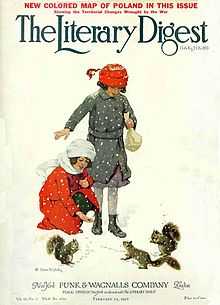The Literary Digest
 Cover of the 19 February 1921 edition of The Literary Digest. | |
| Founder | Isaac Kaufmann Funk |
|---|---|
| First issue | 1890 |
| Final issue | 1938 |
| Company | Funk & Wagnalls |
| Country | United States |
| Based in | New York City |
| Language | English |
The Literary Digest was an influential general interest weekly magazine published by Funk & Wagnalls. Founded by Isaac Kaufmann Funk in 1890, it eventually merged with two similar weekly magazines, Public Opinion and Current Opinion.
History
Beginning with early issues, the emphasis was on opinion articles and an analysis of news events. Established as a weekly newsmagazine, it offered condensations of articles from American, Canadian and European publications. Type-only covers gave way to illustrated covers during the early 1900s. After Isaac Funk's death in 1912, Robert Joseph Cuddihy became the editor.[1] In the 1920s, the covers carried full-color reproductions of famous paintings. By 1927, The Literary Digest climbed to a circulation of over one million. Covers of the final issues displayed various photographic and photo-montage techniques. In 1938, it merged with the Review of Reviews, only to fail soon after. Its subscriber list was bought by Time.[1]
A column in the Digest, known as "The Lexicographer's Easy Chair", was produced by Frank Horace Vizetelly.[2] Ewing Galloway as assistant editor at the publication.[3]
Presidential poll
The Literary Digest is best-remembered today for the circumstances surrounding its demise. As it had done in 1920, 1924, 1928 and 1932, it conducted a straw poll regarding the likely outcome of the 1936 presidential election. Before 1936, it had always correctly predicted the winner.
The 1936 poll showed that the Republican candidate, Governor Alfred Landon of Kansas, was likely to be the overwhelming winner.[4] This seemed possible to some, as the Republicans had fared well in Maine, where the congressional and gubernatorial elections were then held in September, as opposed to the rest of the nation, where these elections were held in November along with the presidential election, as they are today. This outcome seemed especially likely in light of the conventional wisdom, "As Maine goes, so goes the nation", a saying coined because Maine was regarded as a "bellwether" state which usually supported the winning candidate's party.
In November, Landon carried only Vermont and Maine; President Franklin Delano Roosevelt carried the 46 other states. Landon's electoral vote total of eight is a tie for the record low for a major-party nominee since the American political paradigm of the Democratic and Republican parties began in the 1850s. The Democrats joked, "As goes Maine, so goes Vermont." The magazine was so discredited by this discrepancy that it soon folded.
In retrospect, the polling techniques employed by the magazine were to blame. Although it had polled ten million individuals (of whom about 2.4 million responded, an astronomical total for any opinion poll),[5] it had surveyed firstly its own readers, a group with disposable incomes well above the national average of the time, shown in part by their ability still to afford a magazine subscription during the depths of the Great Depression, and then two other readily available lists: that of registered automobile owners and that of telephone users. Research published in 1972 and 1988 concluded that non-response bias was the primary source of this error, although their sampling frame was also quite different from the vast majority of voters.
George Gallup's American Institute of Public Opinion achieved national recognition by correctly predicting the result of the 1936 election and by also correctly predicting the quite different results of the Literary Digest poll to within about 1%, using a smaller sample size of 50,000.[5] Gallup's last poll before the election predicted Roosevelt would receive 56% of the popular vote. The official tally gave Roosevelt 61%.
This debacle led to a considerable refinement of public opinion polling techniques and later came to be regarded as ushering in the era of modern scientific public opinion research.
See also
References
- Freedman, David; Pisani, Robert; Purves, Roger (2007). Statistics (4th ed.). New York: Norton. ISBN 0-393-92972-8.
- ↑ 1.0 1.1 "Press: Digest Digested". Time. 23 May 1938. Retrieved 8 March 2010.
- ↑ "A word a day Man: a biography". Biographical essay. Centre d'études du 19e siècle français Joseph Sablé. Retrieved 18 October 2010.
- ↑ "Ewing Galloway Collection of Photographs". Special Collections Research Center. Syracuse University Library. Retrieved 4 June 2013.
- ↑ Straw Vote Fight Arouses Interest The Pittsburgh Press; November 2, 1936
- ↑ 5.0 5.1 Freedman, et al.: 335-336